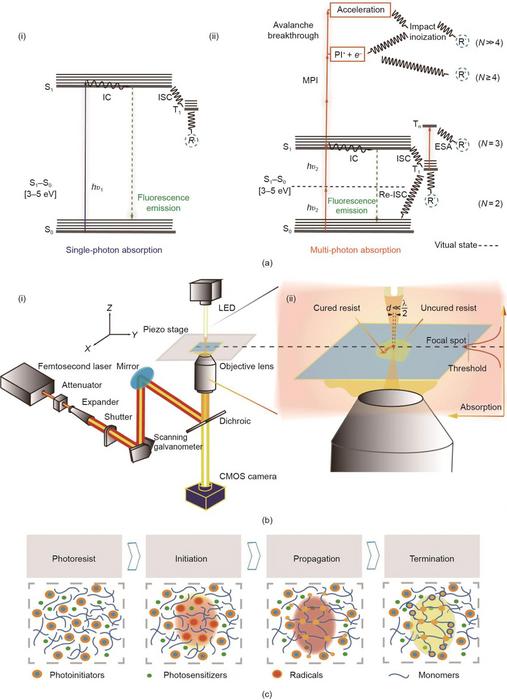
A groundbreaking review article recently published in Engineering provides profound insights into the innovative field of multiphoton polymerization (MPP)-based micro/nanomanufacturing and its transformative potential in precision medicine. As the healthcare landscape advances, researchers are increasingly recognizing the paramount importance of tailoring medical treatments and technologies to individual patients, paving the way for personalized approaches in diagnostics and therapeutics. Within this context, MPP emerges as an exceptional technique to fabricate highly complex and finely detailed microstructures that can play instrumental roles in the delivery of drugs, modeling of tissues, and enhancement of surgical methods.
Multiphoton polymerization stands out due to its noncontact and high-precision capabilities, allowing for the construction of intricate structures with submicron precision. Utilizing the principles of light-induced polymerization reactions, MPP enables the creation of devices crafted with extraordinary accuracy. The unique wealth of opportunities presented by this technique underscores its significant relevance in the burgeoning field of precision medicine, where the fabrication of micro/nanoscale tools is essential for effective drug delivery systems, diagnostic techniques, and therapeutic interventions.
The review article systematically explores the foundational principles underlying MPP, including the multiphoton absorption theorem which serves as the basis for this technology. This theorem describes how photons interact with matter, resulting in the absorption of two or more photons simultaneously to initiate a polymerization reaction. This distinctive absorption process is pivotal for the successful execution of MPP, allowing researchers to manipulate and control intricate polymer networks that form during the polymerization process.
In addition to presenting core theoretical concepts, the article highlights the essential materials utilized in MPP. Researchers investigate commercial photoresists alongside specialized blends of photoinitiators and photopolymers, which must meet specific requirements to be deemed suitable for biomedical applications. This meticulous selection of materials is crucial, as they often dictate the efficacy and safety of the fabricated devices, especially when applied in medical contexts that necessitate compliance with rigorous safety standards.
Moreover, the review delves deep into the expansive array of biomedical applications enabled by MPP. Notably, it discusses the development of microrobots and microneedles designed for sophisticated drug and cell delivery mechanisms, which promise to enhance the efficacy of treatment regimens while minimizing invasiveness. These advancements could revolutionize patient care, allowing for targeted therapies delivered directly to affected tissues, thereby maximizing therapeutic outcomes with minimal side effects.
Equally significant is the use of MPP in microtissue modeling, which holds incredible promise for drug screening and disease modeling. By accurately replicating the structural and functional characteristics of human tissues, scientists can more effectively test new pharmaceuticals and understand disease mechanisms in a controlled environment. This approach transforms traditional drug development pathways, enabling the acceleration of breakthroughs that could potentially lead to rapid advancements in patient treatment options.
In surgical contexts, MPP’s versatility shines through applications including photodynamic therapy, a treatment modality where light is used to activate photosensitizing agents that selectively target cancer cells. Additionally, micromanipulation and cell sorting facilitated by MPP technology can assist in obtaining precise cellular interactions and tissue arrangements, promoting advancements in regenerative medicine.
However, while the article shines a light on the thrilling applications of MPP, it does not shy away from addressing the multifaceted challenges that remain in the pursuit of effective implementation in precision medicine. Prominent among these challenges is the need to ensure the biosafety of the materials used in creating micro/nanodevices. Future research must focus on evaluating long-term interactions between these materials and biological systems to confirm that they do not induce adverse reactions in vivo.
Similarly, there is an urgent necessity to enhance the mechanical properties and functionalities of the materials employed in MPP processes. Current limitations in material strength and reliability can impede the practical application of MPP devices in clinical settings, particularly where they may encounter mechanical stress during use. Addressing these issues is fundamental for the advancement of this technology into mainstream medical applications.
Furthermore, improving the efficiency and resolution of the manufacturing process is critical. As MPP evolves, efforts must be made to refine the precision of the polymerization process, ensuring that newly designed devices can meet the rigorous performance standards required in medical environments. This aspect extends beyond mere accuracy, encompassing the optimization of production durations and costs, which are vital for broad healthcare accessibility.
Despite these hurdles, the article paints a promising picture for the future of MPP in precision medicine through ongoing research and development. Experts assert that with further advancements and innovations, MPP has the potential to overcome its existing limitations and become a staple technology in medical settings. The impetus for future exploration encourages a deeper investigation into material properties, structural design paradigms, and the refinement of process methodologies tailored to micro/nanoscale fabrication challenges.
The implications of MPP extend far beyond the laboratory, holding transformative potential for enhancing the precision of diagnoses and treatments available to patients. With continued exploration and innovation in this domain, the vision of future medical solutions is one that is not only personalized but also optimized for patient welfare.
As the discourse around the potential of MPP-based micro/nanomanufacturing unfolds, it is clear that this field is poised to make substantial contributions to precision medicine. The insights provided in the review article serve as a catalyst for fostering dialogue and inspiring further research into how this technology can improve health outcomes for patients around the globe.
The research article “Multiphoton Polymerization-based Micro/Nanomanufacturing Toward Precision Medicine” authored by Jiarui Hu and colleagues acts as a comprehensive guide outlining both the current advancements and future possibilities in the realm of precision medicine. This work underlines the crucial intersection between emerging technologies and healthcare, providing a roadmap for researchers and practitioners alike who wish to harness the power of MPP in fostering healthcare innovation for tomorrow.
As MPP continues to evolve, its adaptability and precision may well redefine paradigms in precision medicine, ultimately leading the way toward superior diagnostic, therapeutic, and preventative solutions for patients everywhere.
Subject of Research: Multiphoton polymerization-based micro/nanomanufacturing for precision medicine.
Article Title: Multiphoton Polymerization-based Micro/Nanomanufacturing Toward Precision Medicine.
News Publication Date: 27-Nov-2024.
Web References: Link to the article.
References: Jiarui Hu, An Ren, Weikang Lv, Abdellah Aazmi, Changwei Qin, Xinyi Liang, Xiaobin Xu, Mengfei Yu, Qi Li, Huayong Yang, Liang Ma.
Image Credits: Jiarui Hu et al.
Keywords: Precision medicine, multiphoton polymerization, micro/nanomanufacturing, biomedical applications, drug delivery, microtissue modeling, photodynamic therapy.
Tags: complex microstructure fabricationdiagnostic techniques in healthcaredrug delivery systems innovationslight-induced polymerization principlesmicro/nanomanufacturing techniquesmultiphoton absorption theoremmultiphoton polymerization technologypersonalized medical treatmentsPrecision Medicine Advancementssubmicron precision fabricationtherapeutic interventions developmenttransformative potential in healthcare





